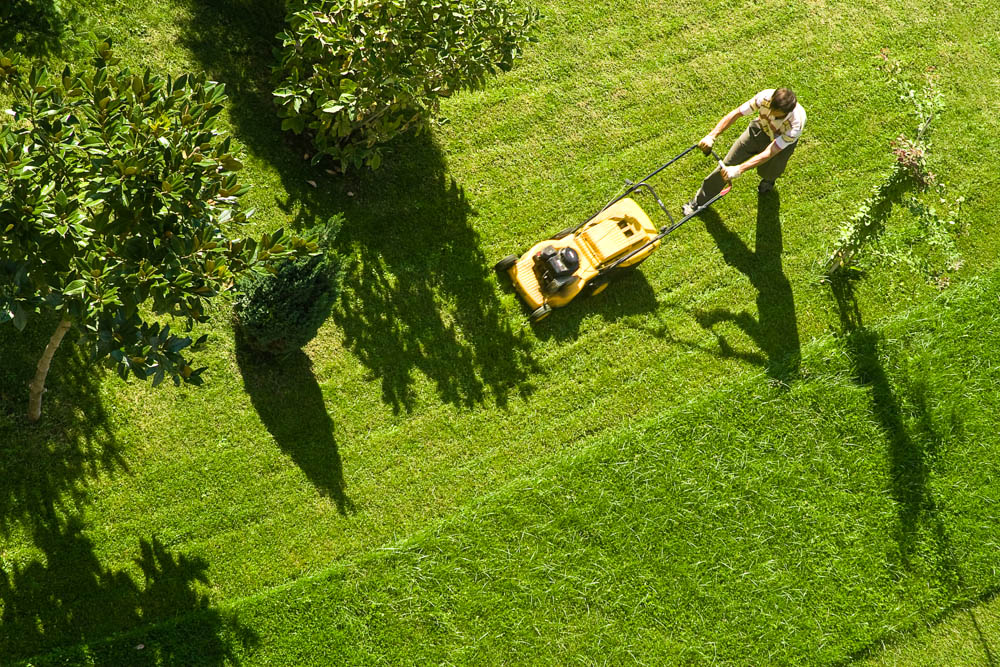Frequent spring rains often sidetrack lawn-mowing schedules, tempting lawn-owners to get out there and cut the wet grass before it gets too long.
Bad idea.
You’re better off waiting until drier conditions so you don’t harm the grass, the soil underneath, and maybe even yourself.
Mowing wet grass poses six potential problems:
1. Clumping
Wet grass clippings stick together, causing clumps that can clog the mower chute and make the engine work harder.
Some clumps also drop onto the lawn. If you don’t go back and remove them, they’ll shut off sunlight to the grass underneath, smothering it and causing yellow or brown spots in the lawn.
2. Uneven cut
Running mower wheels over wet grass pushes the softened grass blades down, making flattened tracks that the mower blades can’t cut. You’ll then end up with a raggedy, uneven job as those drying, uncut grass blades spring back up.
3. Compacted soil
Running mower wheels over soft, wet ground – especially heavy riding mowers – also compresses the soil and leaves behind compacted conditions that discourage good root growth.
In really wet conditions, you can see the results in tire tracks or ruts made in the soil.
Even foot traffic on wet soil can lead to compaction.
Bottom line: Stay off soil that’s muddy, squishy, or that feels soft when you step on it.
4. Damage to young grass
If you’ve ever pulled weeds in wet soil, you’ll know they come out easier than in dry soil. The same is true for grass plants.
Making turns when cutting wet grass exerts pressure on blades – enough that it can uproot young or poorly rooted grass.
5. Disease and weed spread
Many disease-causing fungal pathogens thrive in damp conditions, such as brown patch, powdery mildew, and red thread.
By mowing infected blades and spreading them more readily thanks to the clumping of wet clips, you’ll move infections throughout the lawn.
Ditto for weeds. If you’re mowing grass that has mature weed seeds, those seeds will stick and spread more readily to other areas.
This reason is why it’s not a good idea to mow early in the morning or right after lawn irrigation either. You might not compact the soil as much as after a soaking rain, but you’ll still run an increased risk from clumping and disease/weed spread when grass blades are damp.
6. People hazards
Running a riding mower over wet grass – especially on slopes – increases the risks that the mower will slip, slide, or even flip over. Not only is the surface slippery, but wet grass clippings stick to wheels and reduce traction.
Even with walk-behind mowers, it’s easier to slip on a wet lawn.
And if you’re using a corded electric mower, wet conditions pose an increased shock hazard.
What if you just can’t wait?

delihayat / E+ / via Getty Images
If it’s been raining and raining or you just can’t wait until drier times, at least cut the grass on the highest setting. Then go back a few days later and make a second cut at the normal height. This helps make a more even cut and avoids the stress of lopping off too much of your grass blades in one pass. (It’s best to mow often enough and high enough that you’re never removing more than the top one-third of grass blades at a time.)
Also helpful when trying to cut wet grass: make sure the mower blades are sharp; keep the chute free of clumps, and remove any clumps or mats from the lawn surface as soon as you’re done mowing.
Read more on the best way to mow a lawn